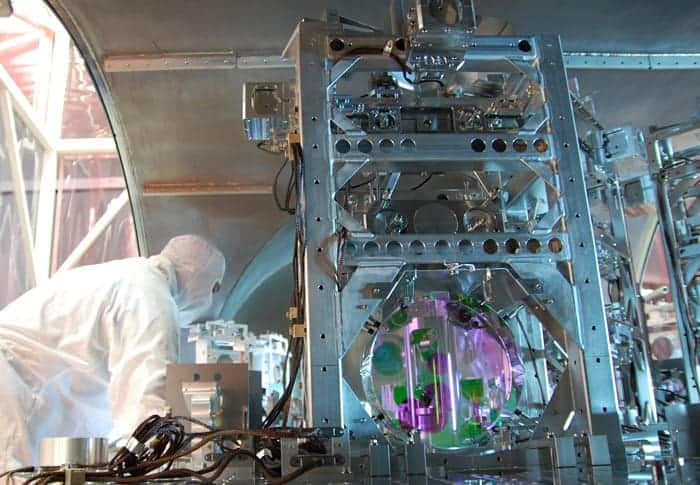
The Indian government has given the go-ahead for a gravitational-wave detector to be built in the country. The Laser Interferometer Gravitational-Wave Observatory – India (LIGO-India) is expected to be operational by 2030 and will be located in Aundh in the state of Maharashtra. It will cost an estimated $3.1bn (INR 26bn) to build.
The LIGO-India detector will be an identical copy of the two Advanced LIGO (a-LIGO) observatories located in the US at Hanford, Washington, and Livingston, Louisiana, which each consist of an L-shaped interferometer with 4 km-long arms. In 2015 researchers working at the two detectors announced the first direct detection of gravitational waves.
LIGO-India will be built by a collaboration between the California Institute of Technology (Caltech), the Massachusetts Institute of Technology (MIT) and four Indian institutes. These are the Raja Ramanna Center for Advanced Technology (RRCAT), Indore; the Institute for Plasma Research (IPR), Ahmedabad; the Inter-University Centre for Astronomy and Astrophysics (IUCAA), Pune; and the construction arm of the Department of Atomic Energy in Mumbai.
As well as providing the interferometer’s hardware and design data, Caltech and MIT will help to install the new facility. India, meanwhile, will build the vacuum system and other infrastructure to house and operate the interferometer. IUCAA will lead in gravitational-wave science and data computation, while RRCAT will assemble the laser and mirror, and the IPR will install the high-vacuum system.
Having first recieved “in-principle” approval from the Indian government in 2016, India has already started some pre-construction work, including designing the LIGO-India buildings, laying roads to the site and fabricating and testing vacuum chambers. Once operational, the observatory will work with the existing network of gravitational-wave detectors – the two aLIGO detectors in the US, Virgo detector in Italy, and the KAGRA detector in Japan – to allow gravitational-wave sources to be better pinpointed and monitored.
The project will be a great source of learning and excitement for future generations of young physicists in India
Qudsia Gani
“Until know, we have had a limited view of the universe,” says Caltech physicist Rana Adhikari, who helps lead the development of LIGO India. “With LIGO-India, we have three immediate upgrades to the world’s gravitational capabilities: finding signals in parts of the sky that LIGO is blind to, being able to point astronomers to the precise location of these explosions, and, perhaps most importantly, being able to measure both polarizations of gravitational waves.”
‘Exciting’ opportunities
Tarun Souradeep, director of Raman Research Institute, Bangalore who is a former spokesman of LIGO-India, says that the project will bring together researchers in fundamental and applied sciences and high-end technology, from national research laboratories, universities and industry.

Indian gravitational-wave observatory wins governmental approval
Early-career physicists in India are also excited that LIGO-India is finally moving ahead. “LIGO-India offers cutting-edge research opportunities to young researchers in laser physics, optics and computing, besides general physics,” says Qudsia Gani, from the Government College for Women in Srinagar. “LIGO-India provides an opportunity to the Indian researchers who would otherwise have needed to go elsewhere to pursue research in such fields.”
Some of those opportunities have already begun, with Indian students working with the aLIGO team as part of Caltech’s Summer Undergraduate Research Fellowship (SURF) programme. Caltech also plans to invite several visiting scientists from India to work at aLIGO. “The project will be a great source of learning and excitement for future generations of young physicists in India,” adds Gani.
- SEO Powered Content & PR Distribution. Get Amplified Today.
- Platoblockchain. Web3 Metaverse Intelligence. Knowledge Amplified. Access Here.
- Minting the Future w Adryenn Ashley. Access Here.
- Source: https://physicsworld.com/a/india-gives-green-light-to-gravitational-wave-observatory/



